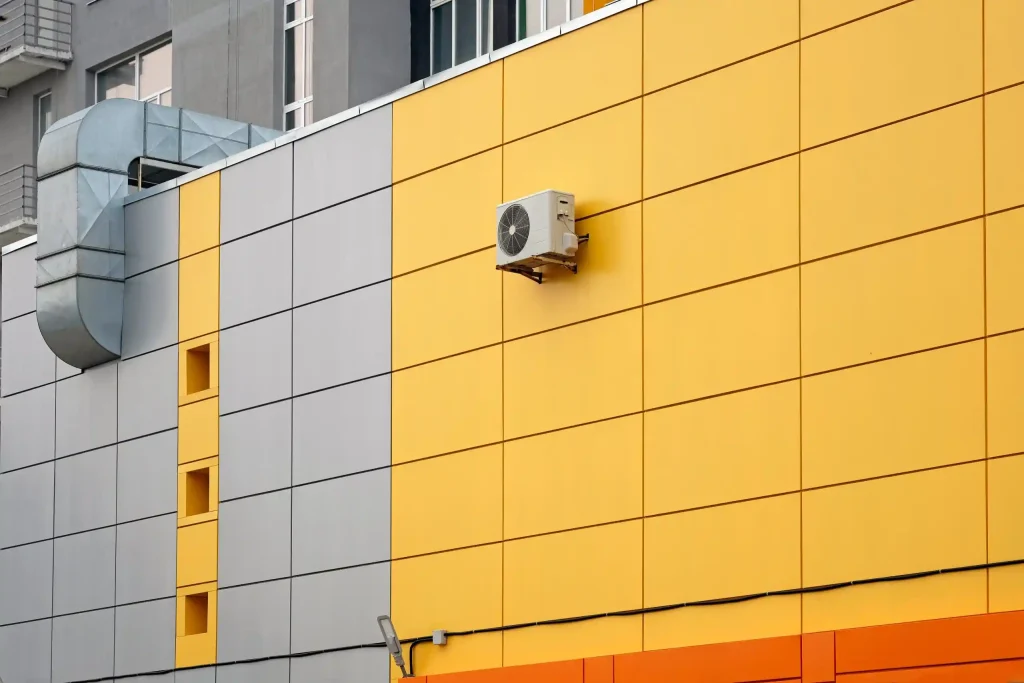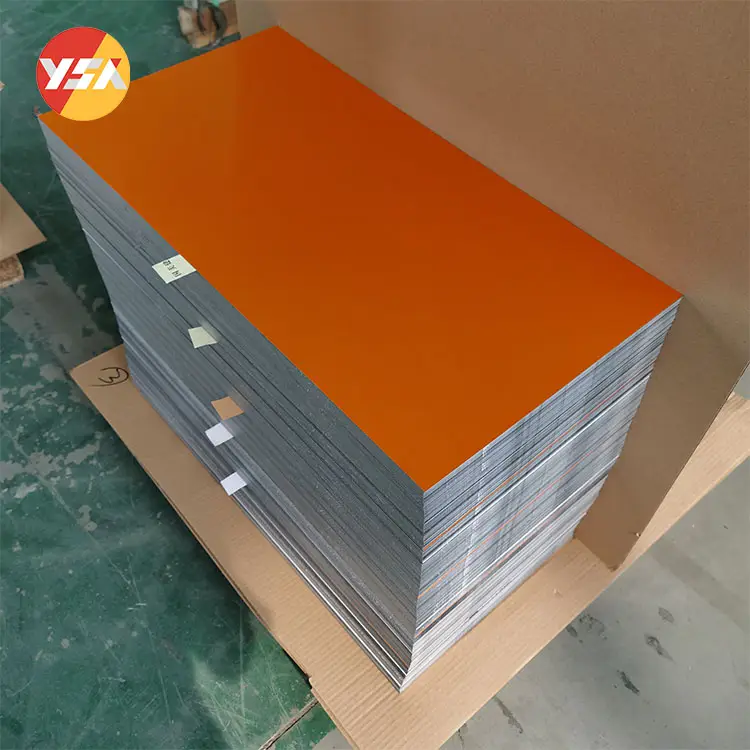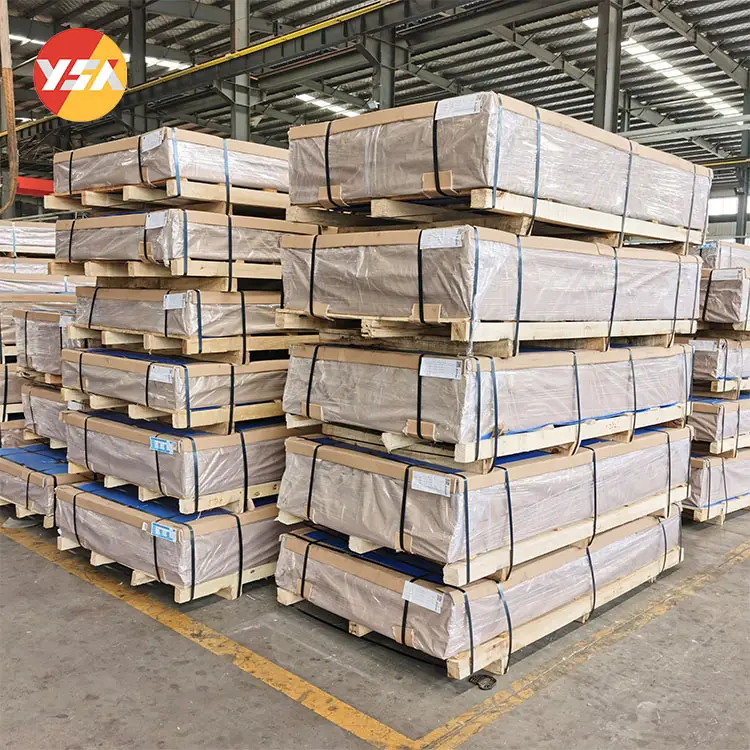ACP

Introduction of ACP
ACP stands for Aluminum Composite Panel. It is a type of flat panel that consists of two thin aluminum sheets bonded to a nonaluminum core material. The core material is typically made of a low-density polyethylene (LDPE) or a fire-resistant core (FR). The aluminum sheets are usually coated with a protective paint finish, such as polyester or PVDF (Polyvinylidene Fluoride).
The aluminum sheets offer weather resistance, corrosion resistance, and aesthetic appeal. The panels can be easily cut, bent, and shaped to fit different design requirements.
Aluminum Composite Panels are a popular choice in the construction industry due to their functional and aesthetic properties, making them suitable for a wide range of applications.
ACP Applications
Aluminum composite panel is widely used in the construction industry for its lightweight, durability, and versatility. It offers a combination of rigidity, strength, and ease of installation. Aluminum composite panels are commonly used for external cladding of buildings, signage, interior decoration, and various architectural applications.

The ACP Construction Process
An aluminum composite panel is constructed by bonding the core material in between aluminum sheets. This bonding process is usually accomplished by applying heat and pressure along with an adhesive or by applying adhesive to the aluminum sheets through a process known as “coil coating” prior to lamination. This is a basic rundown of the steps involved in creating an aluminum composite panel:
1.Aluminum Sheet Preparation: To guarantee correct adhesion to the core material, thin aluminum sheets must first be cleaned, degreased, and treated on the surface. Usually, premium aluminum alloys that resist corrosion are used to make the sheets.

2. Core Material Preparation: Extrusion or lamination techniques are used to prepare the core material, which is typically fire-resistant core (FR) or low-density polyethylene (LDPE). The aluminum composite panel’s core material gives it structural integrity, insulation, and soundproofing.
3. Bonding Process: To assemble the aluminum sheets and the core material, a bonding process is employed. A specialty adhesive—often a high-strength adhesive film—is applied to the core material’s two sides. Subsequently, the adhesive-coated core material is pressed onto the prepared aluminum sheets.
4. Application of Pressure and Heat: The assembled ACP sandwich structure is subjected to pressure and heat in order to ensure proper bonding. Usually, this process is done in a hot press with precisely controlled temperature and pressure to get the best adhesion between the layers.
5. Trimming and Cutting: The aluminum composite panels are trimmed and cut to the appropriate sizes and shapes after they have been bonded and allowed to cool. Usually, machinery or specialized cutting tools are used for this.
6. Surface Treatment and Finishing: A protective paint finish, such as polyester or PVDF (Polyvinylidene Fluoride), is applied to the aluminum surfaces of the aluminum composite panel. The panels are made weather resistant, durable, and aesthetically pleasing by this coating. Techniques for rolling, spraying, or coil coating may be used during the coating process.
7. Quality Control and Inspection: To guarantee that the sheets of ACP fulfill the necessary standards and specifications, aluminum sheets manufacturers carry out strict quality control procedures. This entails examining the panel’s overall integrity, dimensional accuracy, surface finish, and bonding.

Advantages of Aluminum Sheets in Aluminum Composite Panels
1. Lightweight: Since aluminum is a lightweight material, handling and installing Aluminum Composite Panels is made easier. This makes handling and transportation of the building structure easier and lowers its overall weight.
2. High Strength: Aluminum has a great strength-to-weight ratio in spite of its lightweight design. Because ACP uses aluminum sheets, the panels have structural strength and rigidity that makes them appropriate for a variety of uses, including external cladding.
3. Weather Resistance: Aluminum is very impervious to rust and weathering. Usually, protective finishes like polyester or PVDF are applied to the aluminum sheets used in ACP, strengthening their resistance to weather. Because of this, aluminum composite panels can withstand exposure to a variety of challenging environmental factors, such as UV radiation, moisture, and temperature fluctuations, without suffering appreciable degradation.
4. Aesthetic Appeal: The sleek, contemporary appearance of aluminum sheets in ACP improves the buildings’ visual appeal. The panels allow for a multitude of design possibilities and customization because they can be produced in an extensive array of colors, finishes, and patterns.
5. Durability: Aluminum is a long-lasting, sturdy material. The durability and resilience to abrasion of aluminum sheets used to make aluminum composite panels are well-known. Even in harsh settings, they keep their structural integrity and beauty.

6. Easy Maintenance: Aluminum composite panels with aluminum sheets require minimal maintenance. The smooth and nonporous surface of aluminum makes it easy to clean and maintain. Routine cleaning with mild detergents and water is usually sufficient to keep the panels looking fresh and new.
7. Fire Resistance: Aluminum has inherent fire-resistant properties, and Aluminum composite panels with fire-resistant cores offer enhanced fire performance. This makes them suitable for use in buildings where fire safety is a concern.
8. Versatility: Aluminum composite panels with aluminum sheets are highly versatile and can be used in various architectural applications. They can be easily cut, shaped, and formed to meet specific design requirements, allowing for creative and innovative building designs.
Overall, the use of aluminum sheets in ACP provides lightweight, high strength, weather resistance, aesthetic appeal, durability, ease of maintenance, fire resistance, and versatility, making Aluminum composite panels a popular choice in the construction industry.
Yongsheng Aluminum Sheets

ACP is usually used for construction and signs. 1100 aluminum sheets are mostly used for building exterior walls, and 3003/5052 aluminum sheets is used for high strength requirements. Signs are usually made of 1xxx aluminum. Sometimes embossed sheets are used in decoration, and if there are requirements for colors, we can choose color coated aluminum sheets or even wood grain aluminum sheets.
Aluminum sheets can be customized to fit the specific dimensions and requirements of the ACP.
The specifications and features of ACP may vary depending on the manufacturer and the specific product. When choosing, it is advisable to consult a professional to ensure that they fit your needs.
Aluminum Sheets:
Aluminum Alloy: 1000, 3000, 5000, 6000aluminum, etc.
Temper: O-H112, T3-T8, etc.
Surface Treatment: Mill finish, coated, anodized, mirror, embossed, checkered, 15 bar, etc.
Thickness: 0.2mm500mm
Width: 100 mm2600 mm
Length: Any length, according to the transportation, usually less than 12m.
Surface Treatment: Mill finish, color coated, anodized, embossed, polished mirror aluminum, etc.
Application:ACP outer layer, roofing, ceiling, cladding, gutter, facade wall, etc.
Packaging: Seaworthy wooden pallet, wooden case, aluminum sheet case.

Henan Yongsheng Aluminum Co., Ltd. is located in the industrial cluster of Gongyi City, Henan Province. Our factory focuses on the production and development of aluminum products such as aluminum sheet/coil, aluminum foil, aluminum strip, color coated aluminum sheet/coil, aluminum circle, embossed aluminum, aluminum checker sheet, mirror aluminum sheets, antiskid aluminum sheet and so on.
The factory covers an area of 10,000 square meters and has 276 employees. All our products are independently produced to provide you with excellent service with fast delivery, high-quality assurance, factory prices, and professional customer service staff. You are welcome to visit the factory and look forward to establishing a long-term good business relationship with you.

Regular Maintenance for ACP
Regular maintenance for Aluminum Composite Panels (ACP) can help ensure their longevity and preserve their aesthetic appearance. Here are some general maintenance tips for Aluminum composite panels:
1. Regular Cleaning: Clean the Aluminum composite panel periodically to remove dust, dirt, and other debris that may accumulate on the surface. Use a soft cloth or sponge, along with mild soap or detergent mixed with water, to gently wash the panels. Avoid using abrasive cleaners or harsh chemicals that can damage the protective coating.
2. Rinse with Water: After cleaning, rinse the panels thoroughly with clean water to remove any soap residue. This helps prevent streaking and ensures a clean finish.
3. Inspect for Damage: Regularly inspect the Aluminum composite panel for any signs of damage, such as dents, scratches, or chipping of the protective coating. If any damage is found, it should be repaired promptly to prevent further deterioration and maintain the panel’s integrity.
4. Avoid Abrasive Materials: Do not use abrasive materials, harsh brushes, or abrasive cleaning pads on the Aluminum composite panel, as they can scratch or damage the surface. Stick to soft cloths, sponges, or nonabrasive cleaning tools.
5. Avoid High-Pressure Washing: While Aluminum composite panels are generally resistant to water, it is advisable to avoid high-pressure washing, as it may force water into panel joints or damage the protective coating. Use a gentle water stream or low pressure washing if necessary.
6. Check Sealants and Joints: Inspect the sealants and joints between the Aluminum composite panel regularly. Ensure that they are intact and properly sealed. Any damaged or deteriorated sealants should be repaired or replaced promptly to maintain the panel’s weather resistance and prevent water infiltration.
7. Avoid Chemical Exposure: Avoid exposing the Aluminum composite panel to strong chemicals, solvents, or abrasive substances, as they can damage the protective coating. If any chemical spills occur on the panels, clean them immediately with water.
8. Follow Manufacturer’s Guidelines: Always follow the manufacturer’s guidelines and recommendations for cleaning and maintenance specific to your Aluminum composite panel. Different types of ACPs may have specific care instructions, so it’s important to refer to the manufacturer’s instructions for the best practices.
FAQ: Any recommendations for repairing damaged aluminum composite panels?

When it comes to repairing damaged Aluminum Composite Panels (ACP), the specific approach will depend on the nature and extent of the damage. Here are some general recommendations for repairing common types of damage to Aluminum composite panels:
1. Scratches and Minor Surface Damage:
For minor scratches or surface damage, you can try using a nonabrasive cleaner or a mild detergent mixed with water to gently clean the affected area. Rinse thoroughly with water and wipe dry.
If the scratches are deeper or more noticeable, you can apply a color-matched touchup paint or coating recommended by the ACP manufacturer. Follow the manufacturer’s instructions for application and drying time. This can help conceal the damage and restore the panel’s appearance.
2. Dents and Deformation:
For small dents, you can try using a heat gun or hairdryer to apply gentle heat to the affected area. Heat the area evenly and use a soft cloth or gloved hand to carefully push and massage the dent back into shape. Be cautious not to overheat or damage the panel.
If the dent is larger or more severe, it may require professional repair or replacement of the affected panel. Contact the ACP manufacturer or a qualified professional for guidance and assistance.
3. Delamination or Peeling:
If there is delamination or peeling of the ACP panel layers, it is recommended to consult with the manufacturer or a professional installer for appropriate repair options. Delamination often requires specialized techniques and expertise to restore the panel’s structural integrity.
4. Sealant or Joint Repair:
If the sealants or joints between Aluminum composite panels are damaged or deteriorated, they should be repaired promptly to maintain weather resistance and prevent water infiltration. Remove any loose or damaged sealant and clean the area thoroughly. Apply a compatible sealant recommended by the ACP manufacturer, following their guidelines for proper application and curing. It’s important to note that the best approach for repairing Aluminum composite panels will vary based on the specific product, manufacturer recommendations, and the severity of the damage. Whenever possible, consult the ACP manufacturer or seek professional assistance for proper repair techniques and materials specific to your panels.


